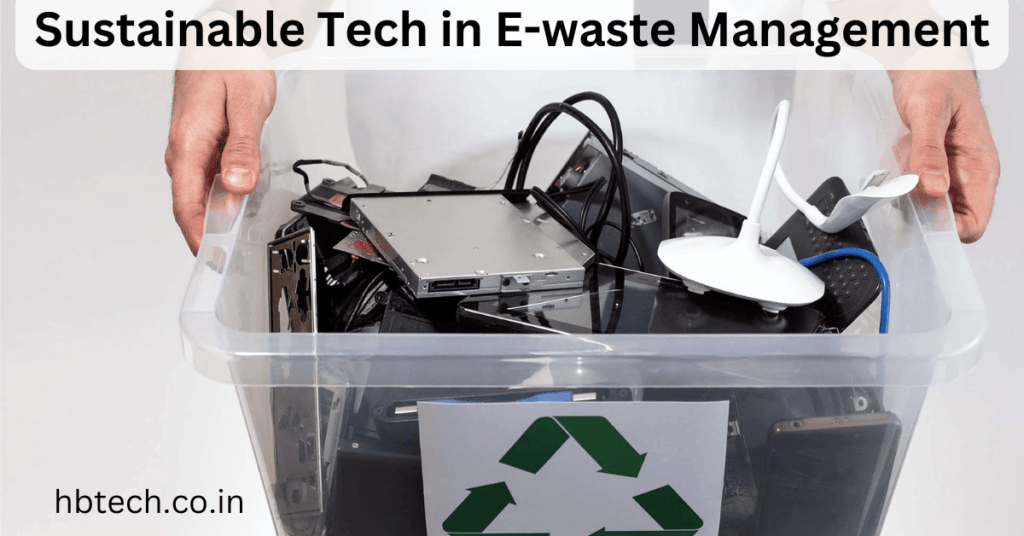With our growing dependence on technology, electronic waste or e-waste, is becoming one of the fastest-growing types of waste . Old gadgets like phones, laptops and TVs often end up in landfills, where they harm the environment and human health. Fortunately, sustainable technology is stepping in with innovative solutions to deal with e-waste responsibly . Let’s dive into how it works, why it matters and what examples we can learn from.
How Sustainable Tech Helps in E-waste Management
Sustainable technology plays a big role in solving the e-waste problem. Instead of relying on harmful methods like burning or dumping electronics, sustainable tech focuses on reducing waste and recycling valuable materials.
- Recycling Breakthroughs : New technologies make it easier to recover valuable materials like gold, silver and rare metals from discarded devices. Automated systems at recycling facilities sort and extract these resources efficiently.
- Eco-friendly Product Design : More companies are designing electronics that are easier to repair, recycle and disassemble, reducing waste .
- Circular Economy Models : Sustainable tech encourages a circular economy where materials are reused and repurposed instead of being thrown away.
Why Sustainable Tech in E-waste Management is Important?
Sustainable tech is essential because the world’s e-waste is growing at an alarming rate. By 2030, e-waste is expected to reach over 74 million tons!
- Protecting the Environment : Recycling reduces pollution and prevents harmful chemicals from leaching into the soil and water .
- Saving Resources : Electronics contain precious materials like gold and rare earth metals, which are finite. Recycling preserves these materials for future use.
- Boosting the Economy : Jobs are created in industries focused on refurbishing, recycling and reselling electronics.
- Improving Health : Responsible handling of e-waste prevents harmful substances from affecting workers and nearby communities.
Real-life Examples of Sustainable E-waste Management
- Recycling Robots : Companies like Apple have created robots like “Daisy,” which dismantle old iPhones and recover valuable components for reuse.
- Blockchain Technology : Blockchain is being used to track e-waste, ensuring it’s handled responsibly and doesn’t end up in illegal dumps.
- Biodegradable Electronics : Scientists are working on devices made with biodegradable materials that naturally break down, reducing waste.
- Recycling Apps : Apps now connect people with certified e-waste recyclers, making it easier for individuals to dispose of electronics responsibly.
About Sustainable E-waste Management
Sustainable e-waste management means taking care of electronics at every stage of their lifecycle. It involves designing products that are easier to recycle, reusing gadgets when possible and safely disposing of hazardous materials. Key practices include:
- Reduce : Use electronics longer and buy products designed to last.
- Reuse : Donate or resell working devices instead of throwing them away .
- Recycle : Recover valuable materials and handle toxic parts safely.
- Regulate : Governments must enforce laws that ensure proper e-waste management.
Learning More: E-waste Management Resources
If you want to learn more, many resources, like PDFs and guides, are available online. These documents include case studies and tips for managing e-waste. Examples of useful PDFs include :
- “The Future of E-waste Management”
- “Recycling Rare Materials for Sustainable Tech”
- “How the Circular Economy Can Solve the E-waste Crisis”
Why We Need E-waste Management Guides (PDFs)
PDF guides and reports on e-waste management are critical for raising awareness. They help educate people and businesses about why e-waste is a problem and how to deal with it. Topics covered in such guides often include:
- The environmental and health effects of e-waste
- New technologies for recycling and recovery
- Steps for individuals and companies to manage e-waste
The growing e-waste problem needs urgent action and sustainable technology provides the tools to tackle it. By adopting better recycling methods, designing eco-friendly products and promoting awareness, we can reduce the damage caused by electronic waste.
Managing e-waste isn’t just good for the planet it’s also a smart economic and social move. Together, we can build a future that’s cleaner and more sustainable for everyone.
Frequently Asked Questions(FAQs)
What is e-waste?
E-waste refers to discarded electronic devices like phones, laptops, and TVs that are no longer in use.
Why is e-waste management important?
Managing e-waste prevents pollution, protects health, saves valuable materials, and creates economic opportunities.
How does sustainable technology help in e-waste management?
Sustainable tech aids through innovations like recycling systems, eco-friendly designs, and circular economy practices.
What are some examples of sustainable e-waste management?
Examples include Apple’s Daisy robot for recycling, blockchain for tracking waste, biodegradable electronics, and recycling apps.
What steps can individuals take to manage e-waste responsibly?
Individuals can reduce, reuse, and recycle electronics and ensure proper disposal through certified recyclers.
Related Posts
- 2-in-1 Laptops: Tablets and Laptops in One
- 5G Technology: What It Is, It Works and Impact on Our Lives
- 8K Gaming on a Laptop: Is It Worth It?
- A Simple Guide to Remote Work: Work from Anywhere, Anytime
- A Visit to the Museum of Jurassic Technology
- Affordable AI Solutions for Small Businesses









